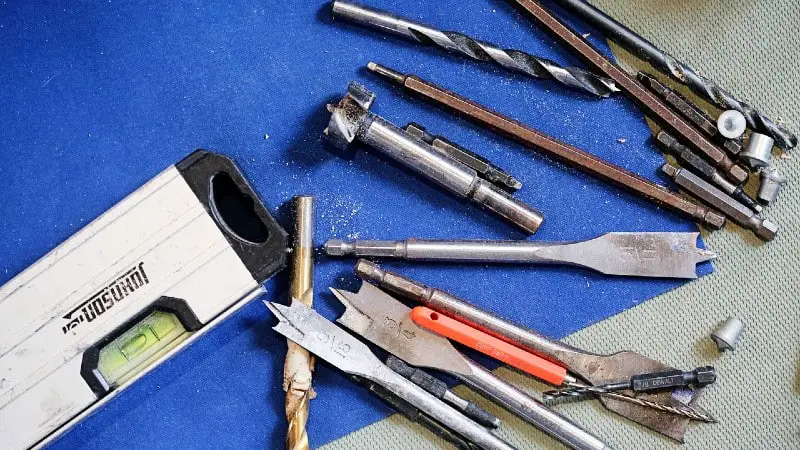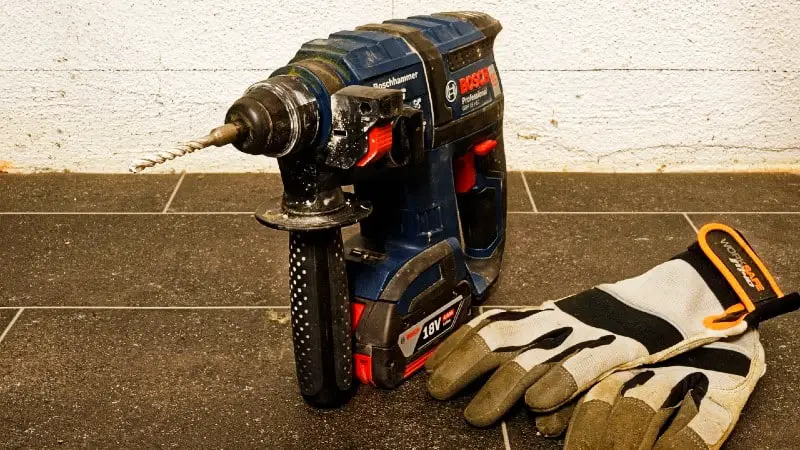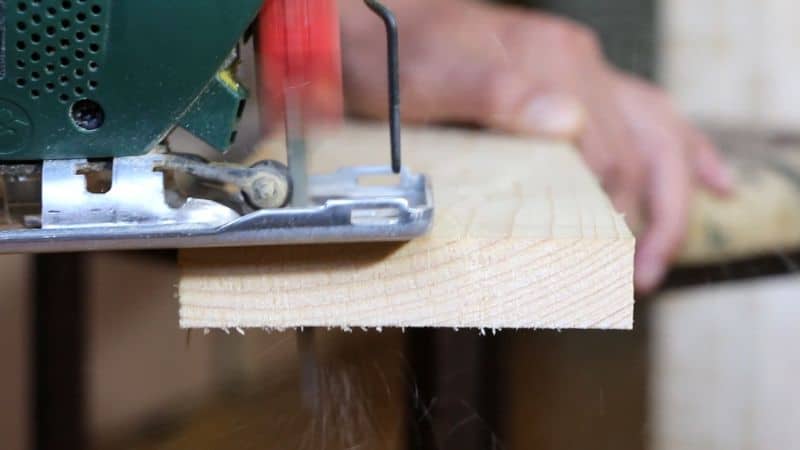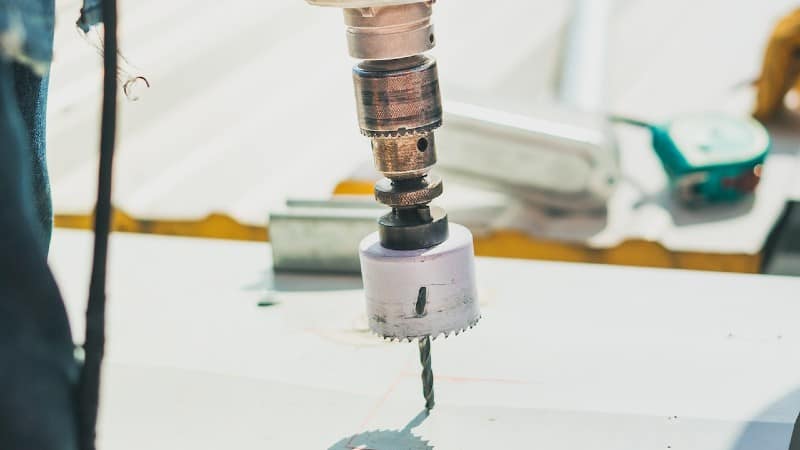It’s happened to all of us. You’ve got a big project in mind, and you’re ready to take it on. But there’s a problem: You need a large hole in the wood.
Whether it’s for an art project or for your new bookshelf, drilling a big hole in wood can be pretty intimidating if you’ve never done it before. But don’t worry—we’re here to help!
So, what’s the answer to the question: How to drill a large hole in wood?
Use a hand or power drill and the appropriate large bit to create your hole. Spade, Forstner, or hole saw bits work well in powered drills. Auger bits are better suited for use with hand braces.
In this blog post, we’ll walk you through the process of drilling a large hole in wood—from selecting the right drill bit to making sure you have enough power to get the job done. And we’ll even talk about some other options for getting those holes drilled so that you can make sure you have everything under control before you start your project!
Table of Contents
- Drilling a large hole in wood
- What if you don’t have a drill?
- What if you don’t have a jigsaw or a drill?
- What if your largest hole saw bit is not big enough?
- Related Questions
- Final words …
Drilling a large hole in wood
If you’ve ever tried to drill a hole in wood, you know it can be tricky. Here are some tips on how to do it safely and efficiently:
1. Tools and materials needed
You’ll need a drill, a drill bit, a ruler, and a pencil—all of these can be found in the hardware section of most stores. You’ll also need wood for your project.
2. Choose the right wood for your project
You should always use the best quality wood that can be found for your project. The better the quality of the wood, the less likely it is to split or crack when drilling into it.
3. Choose the right drill
When you’re drilling large holes in wood, it can be difficult to know which drill is best for the job. Should you go with a cordless model? Or should you opt for corded power? What about a drill driver, mud mixer, or drill press?—or maybe even an old-fashioned hand brace?
Cordless Drills – Cordless drills are great for small projects because they’re portable and lightweight. These drills are some of the most useful tools in any DIYer’s toolkit. They make it easy to drill holes in wood, metal, and plastic.
Corded Drills – Corded drills are a great choice for DIYers and those new to woodworking. They’re easy to handle, versatile, and powerful enough to handle most projects. However, they aren’t as portable or easy to use as cordless ones because you’ll need access to an electrical outlet wherever you want to use them.
Drill driver – The drill driver is used for drilling holes as well as driving screws and other fasteners into wood.
Mud mixer – You could probably use a mud mixer drill, but the speed may not be fast enough for particular bits to work efficiently. I wrote another article about mud mixer drills.
Drill press – The drill press may be a good tool to use for this. Since the chuck is very large, it will accept a large bit for drilling the hole.
Hand brace – A hand brace is a tool that allows the worker to drill holes using auger bits. Usually, one hand holds the brace while the other turns the handle. This can be awkward, especially in confined places. A ratchet handle can help with this, but the brace may not be the best solution.
5. Choose the right drill bit
If you want to drill a large hole in wood, it’s important to choose the right drill bit. There are many different types of drill bits available, and each one is designed to do a different job. Here are several types of drill bits for large holes:
#1. Spade bit – The spade bit is relatively inexpensive and makes a rough cut, which means that it doesn’t leave a smooth edge on the hole you’ve drilled. This is great for projects where you don’t need a perfectly smooth edge, but if you want something that’s more refined-looking, this isn’t the bit for you.
#2. Forstner bit – These are relatively expensive but make a precise and smooth cut through your project piece, so they’re well suited for fine woodworking and cabinetry.
#3. Hole saw bit – Hole saw bits are a great way to drill large holes in wood. It is a hollow cylinder with saw teeth at one end. When you drill into the workpiece, the saw teeth cut a ring. As you progress through the workpiece, this ring becomes a hole.
#4. Auger bit for hand brace – If you’re trying to drill a large hole in wood, an auger bit for a hand brace can be a helpful tool.
The brace is a hand-operated drill, as opposed to the more popular power drills. While it’s not very powerful, it’s easy to use and great for small projects.
6. Measure and mark the hole
It’s always a good idea to mark the hole before drilling into the wood. This way you can be sure that you’re drilling in the right spot and keep from accidentally making a mistake.
7. Minimize splintering
Splintering and tear-out can occur when the drill bit breaks through the underside of the wood, causing a rough hole that is difficult to sand or finish. To minimize this effect, there are two things you can do:
#1. Use a sharp drill bit, which will cut through the wood easier and more evenly.
#2. Clamp a piece of scrap wood underneath the place where the hole will go. Then, drill through the workpiece into the scrap wood.
8. Push down on the drill
Use gentle but steady pressure to drill the hole. Start slowly and gradually increase speed as you go along.
9. Lift the drill out of the hole
Stop pushing downward as soon you have drilled into the scrap piece. Then, lift the drill and bit out of the hole.
10. Sand if needed
You may want to sand the edges of the hole if they’re rough. Always move in the direction of the grain, to avoid making scratches.

What if you don’t have a drill?
If you don’t have a drill, don’t worry! It’s still possible to get the job done. You can use a jigsaw to make a plunge cut through the wood. I wrote another article with 31 tips and tricks for the jigsaw.
A plunge cut is a type of cut made by holding the jigsaw at an angle, and then lowering it into the wood.
a) The blade must be made to make plunge cuts (It should have a sharp tip to cut the wood).
b) The blade needs to be moving at full speed, not just starting up. If you’re not careful, you can snap the jigsaw blade.
c) You need to make sure that the wood you’re cutting is not too thick for the jigsaw. The blade should extend an inch or so down from the underside of the wood. This is to account for the up-and-down motion of the blade.

What if you don’t have a jigsaw or a drill?
Well, good news! There are still ways to cut a large hole in the wood without them. Here’s how:
1. Mark the position for the hole
The first step is to mark the position of the hole. This is important because it helps you make sure that your drill bit will be in the right place, and it prevents you from accidentally drilling through the wrong part of your project.
2. Hammer a nail
Using a hammer and nail, drive it into the center of your marking so that it penetrates all the way through the wood. Be careful not to split, crack, or damage the wood when doing this.
3. Widen the hole with a chisel
Use a chisel to widen the hole produced by the nail and bring it out to the outline of the circle you have marked.
4. Sand and or file as needed
Use sandpaper and or a file to shape the cut and make it smooth. Make sure to sand along the grain of the wood.

Note: This post may contain affiliate links. If you purchase a product through an affiliate link, I’ll earn a commission, at no cost to you. To find out more, see my full disclosure.
What if your largest hole saw bit is not big enough?
Another approach is to use a router and jig to do this. The jig keeps the router at a constant radius from a central point. As a result, it cuts a circle – the circle becomes a hole as the router plunges downward. Here is a circle-cutting jig for the router on Amazon.

Related Questions
1. What is the best bit for making clean holes in wood?
As was mentioned earlier, the Forstner bit makes very clean holes in wood and is the preferred bit for cabinetry and woodworking.
For example, consider the task of drilling holes in pieces that will later accommodate a large dowel. Here, one needs to create clean and precisely sized holes; spade bits would leave too rough an opening.
2. What is the best drill bit for deep holes in wood?
Probably, a spade bit with a very long shaft. See a bit like this on Amazon.
The hole-saw bit has a rotating cylinder that cuts the wood. As you drill deeper and deeper, the top edge of the cylinder will rub up against the workpiece. This limits the depth of the hole you can drill. So, this might not be the best type of bit for the job.
It might be possible to get away with using a twist drill bit, if the shaft is long enough for the deep hole. Also, the drill bit size would have to be big enough for this particular application.
Final words …
So, after reading this blog, you should have a better understanding of how to drill a large hole in wood. It’s not as hard as it looks!
Did you enjoy this article? If so, you might like to visit my Pinterest profile. It contains pins about DIY & Crafts, Woodworking, Tools, Projects, Hardware, and related topics.


